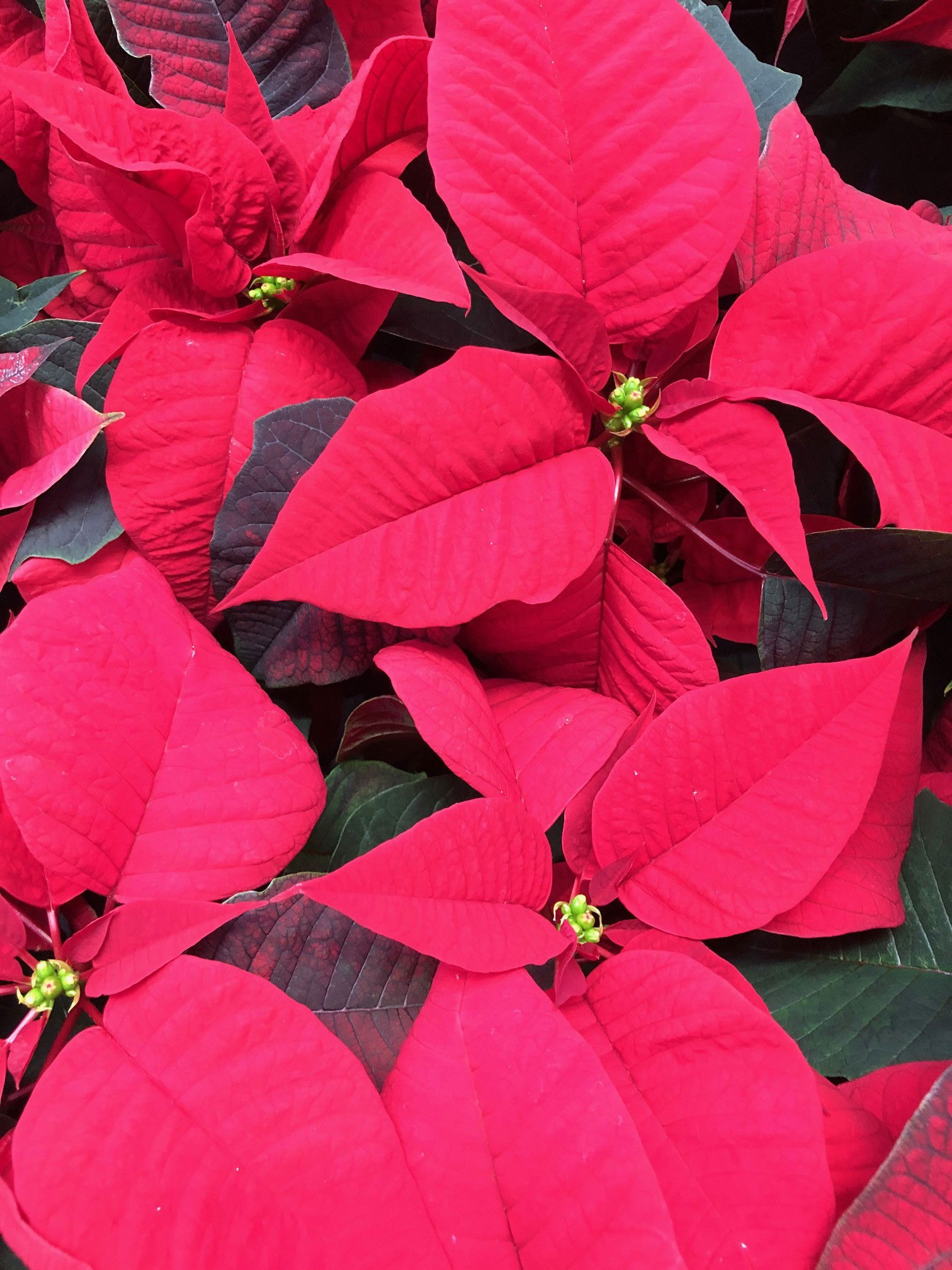
Euphorbia pulcherrima
Listen to the Poinsettia Podcast Here!
Contents
- Top Tips
- Location, Water, Humidity & Fertilisation
- Dormancy Care & Turning Your Poinsettia Red Again for Christmas
- Common Issues
- Origins, Temperature, Propagation, Repotting & Toxicity.
Need the answer to a specific plant query? Book a 1-to-1 video call with THE HOUSEPLANT DOCTOR™, the website's friendly author, to overcome and address your niggling problem! Available on iMessage, WhatsApp, Facebook Messenger & more.
Top Tips & Info
- Care Difficulty - Moderate to Difficult
- Bright, indirect light is best for optimum growth. Those kept in too deep shade or excessive sunlight will result in gradual lower leaf loss.
- Keep the soil evenly moist throughout the festive period, using lukewarm water to avert shocking its roots.
- Average room humidity is acceptable for a Poinsettia, but remember to not situate it within three metres of an operating heat source.
- Fertilise using either a 'Houseplant' or 'Poinsettia' labelled feed every four waters in the spring and summer, reducing this to every six in the colder months.
- Repot every two years using a 'Houseplant' labelled potting mix and the next sized pot.
- Read the third section, 'Dormancy Care', to learn about keeping a Poinsettia after Christmas.
- This plant is known to be 'semi-deciduous' whereby around a third of its older leaves will yellow and drop off. This is a natural part of its yearly cycle, so maintain evenly moist soil and situation it in an east, south or west-facing windowsill to set it up for optimal growth in spring and beyond.
Location & Light - 🔸🔸🔸
A bright, indirect location with a splash of morning or evening sun is the ideal setting for this species. Although direct sunlight is quite beneficial for a Poinsettia, avoid scorching the leaves with too much sun as this will lead to disfigured appearance. If you're worried about its location being too dark, if a newspaper can be read while having your back towards the light source, you're good to go.
The ideal location around the house must be above 15ºC (59ºF) and at least four metres away from an operating heat source. Never locate the plant in a windowsill that's either single-glazed or allows a draught to slip through its panes as this will lead to sudden leaf loss from the lowered temperature.
Water - 🔸🔸🔸
Moist soil is mandatory to ensure a good show of its festive colours throughout the Christmas period. Allow the top quarter of the soil to dry in between irrigations, using lukewarm water to avoid shocking the roots. There's no siding-factor when watering your Poinsettia; most people pour water directly into the soil, whereas others use the bottom-up method by submerging the plant in a pool of water for a short spell. As long as the plant never sits in soggy or standing water unnecessarily, it'll be content. Under-watering symptoms include curled or crispy leaves, wilted foliage, yellowing leaves and stunted growth. Only allow the majority of the soil to become dry once the plant is in its dormancy period after the festive period. The continuation of droughts will result in leaf loss and death in some cases. Over-watering symptoms include lower yellowing leaves, gradual lower leaf loss, stunted growth and wilting. Avoid the soil becoming overly saturated due to the species' susceptibility to root rot and other soilborne diseases. If this has happened to your specimen, increase the intensity light somewhat with fewer irrigations. Over-watering is commonly caused by too little light or heat or a lack of drying soil in between irrigations.
Humidity - 🔸
Average room humidity is enough to satisfy this plant, as long as you don't live in an overly-dry climate. Never situate it within a few metres of an operating radiator due to the enriched chance of browning leaf-tips. If you are indeed worried about dry air, create a humidity tray to provide a moist and stable environment for your plant, which will also have the added benefit of slowing the rates of drying soil!
Fertilisation - 🔸🔸
During the autumn and winter, fertilise every four waters using either a 'Flowering Plant' or 'Poinsettia' feed to promote better flowers and foliage-colouring. From early spring until late summer, revert to a 'Houseplant' labelled fertiliser to help support the vital thirteen nutrients that are needed to grow new green luscious leaves.
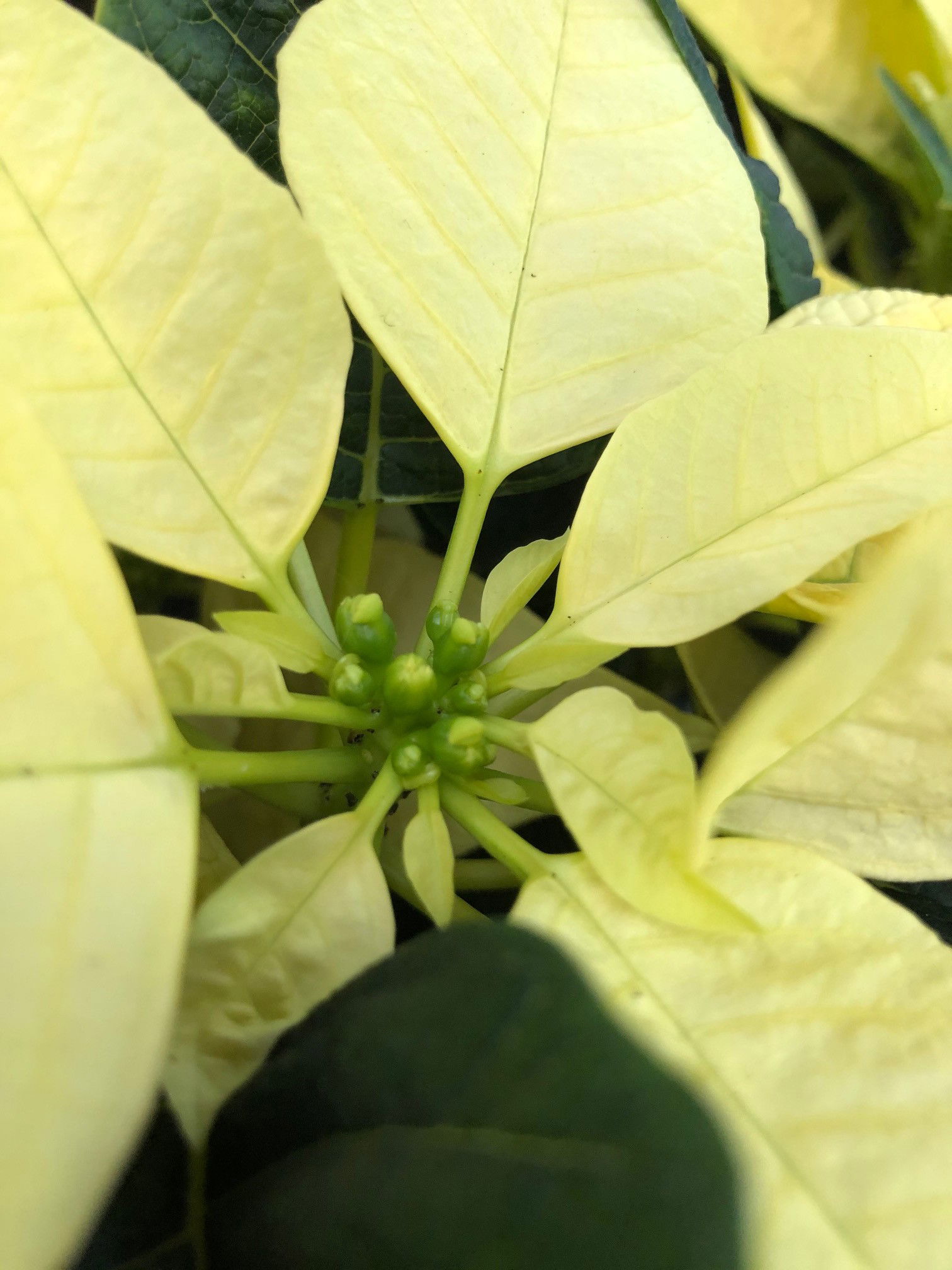 Less traditional Poinsettia colours are starting to mark their mark on the festive market too, which includes yellows, pinks & even oranges!
Less traditional Poinsettia colours are starting to mark their mark on the festive market too, which includes yellows, pinks & even oranges!
Dormancy Care & Turning Your Poinsettia Red Again for Christmas
The old wives' tale of placing a blanket over the foliage overnight from late August onwards is entirely accurate. Although this section will mention care that should be taken from late winter shortly after the Christmas period, other methods can be performed closer to Christmas.
A Good Dormancy Period
Come mid-January, its flowers have finally elapsed, and the red tinges to the leaves and bracts will begin to fade slightly. Most will discard the plant at this point, but if you're a dedicated horticulturalist, you'll at least attempt to keep it until for a few months afterwards. The most critical way in which you can maintain a healthy, long-lasting specimen is by providing a dormancy period soon after Christmas. Although one may think that Poinsettia need a warm location all year round, they'd be wholly wrong. Poinsettia are put through hell and back throughout the year; being divided into stem cuttings in early summer, drowned in a potassium-based fertiliser in Autumn and having to endure artificial lighting with maximum darkness to assist the desired red bracts and foliage in time for Christmas.
With this in mind, surely you'd want to provide a warm location with regular waters to keep the plant happy? Wrong. A long-lasting Poinsettia will have a strong desire for a cooler setting with little fuss - after all, they have been put through the wars this past year! Along with dipping the temperature to around 12ºC (53ºF) until mid-spring, reduce irrigations considerably - once every ten days is sufficient to keep it hydrated. Provide a bright, indirect setting with a possible splash of the direct sun either in the morning or evening, to bunk up its strength.
For those who like bullet points, here are the critical elements of a reasonable dormancy period for a Poinsettia.
- Reduce the temperature to around 12ºC (53ºF) once the flowers are elapsed, usually from mid-January.
- Infrequent waters are best; only rehydrate once around half of the soil has dried out in between irrigations.
- If possible, prune the tops of the stems that house only the red leaves, keeping the greener leaves intact. More information about this section in a moment...
- Provide a bright, indirect setting with a possible splash of morning or evening sun. (Before 12am OR after 3pm, but not all day).
- Ease off with the fertilisers; allow the plant to relax during this period to regain its strength.
- Increase waters towards the end of spring. Either keep the plant indoors or place outside once the nighttime temperatures are above 15ºC (59ºF).
 Remove the red bracts shorty after the festive period has ended as it'll help the plant enter its vital dormancy period.
Remove the red bracts shorty after the festive period has ended as it'll help the plant enter its vital dormancy period.
Photoperiodism (The Duration of the Night & Day Light)
The amount of darkness from August until mid-November will be the deciding factor of the leaves' colouration. Poinsettia will naturally flower during the springtime in its natural environment in Mexico, so inflicting a longer period of complete darkness will trick it into believing that winter has approached and is now on the back leg, thus needing to flower to stay in season. During late summer, place the Poinsettia in a room that won't be disturbed by artificial light throughout the night - this could even be a car driving past with its headlights on. Place a box or a blanket completely over the plant, allowing at least fifteen hours of darkness per day, with the offering a good amount of indirect light during the natural daylight hours. The ideal temperature for a Poinsettia during this period is around 15ºC (59ºF). Unfortunately, you'll have to repeat this daily until the bracts and foliage begin to redden, which is usually mid-autumn. Keep the amount of darkness the same until some of the leaves become entirely red (or whichever colour yours should be), increasing the amount of light, watering and temperature gradually. Never immediately place the plant in a location that is wholly different from its original site in the box, as this may lead to environmental shock.
Bullet points to round off the section;
- Reducing the amount of darkness is crucial for the discolouration of its leaves. Artificially place the Poinsettia in a location that'll receive fifteen hours of complete darkness per night from late summer onwards. This can be achieved by placing a box or blanket over the plant during these hours or simply situating it in a dark room at night.
- Any artificial light during the fifteen hours of darkness will hinder the chance of reddening foliage - this could even be the light emerging beneath the door.
- If possible, reduce the temperature down to 15ºC (59ºF), although this is not mandatory for success.
- Repeat the darkness trick in late Autumn once the top foliage and bracts change colour.
Pruning Back
Cutting the plant back in mid-spring is another excellent way to rejuvenate it in time for the upcoming winter. There are two methods of cutting back - hard pruning or top pruning. As mentioned above, Poinsettia are semi-deciduous, meaning that some of the leaves will naturally drop off over the course of the year. Once mid-spring comes along, and a few of its lower leaves have said goodbye, either cut the stems to 10cm stumps or trim the top of the stems that house only the red leaves, keeping the green foliage intact. If you're horticulture-savvy, you can set the pruning in moist soil to increase your stock, given that they are over the 10cm threshold in height. It's mandatory to use a clean pair of secateurs as any messy wounds could result in die-back or even certain diseases. Scroll down to the 'Propagation' section to learn about how to take Poinsettia cuttings.
Note: Although this section may sound mandatory, the plant can be left wholly intact and will still thrive over the year. ukhouseplants recommends using the top pruning method as not only will it promote a bushier appearance, but it will also push out new juvenile growth that's more likely to colour during the festive period.
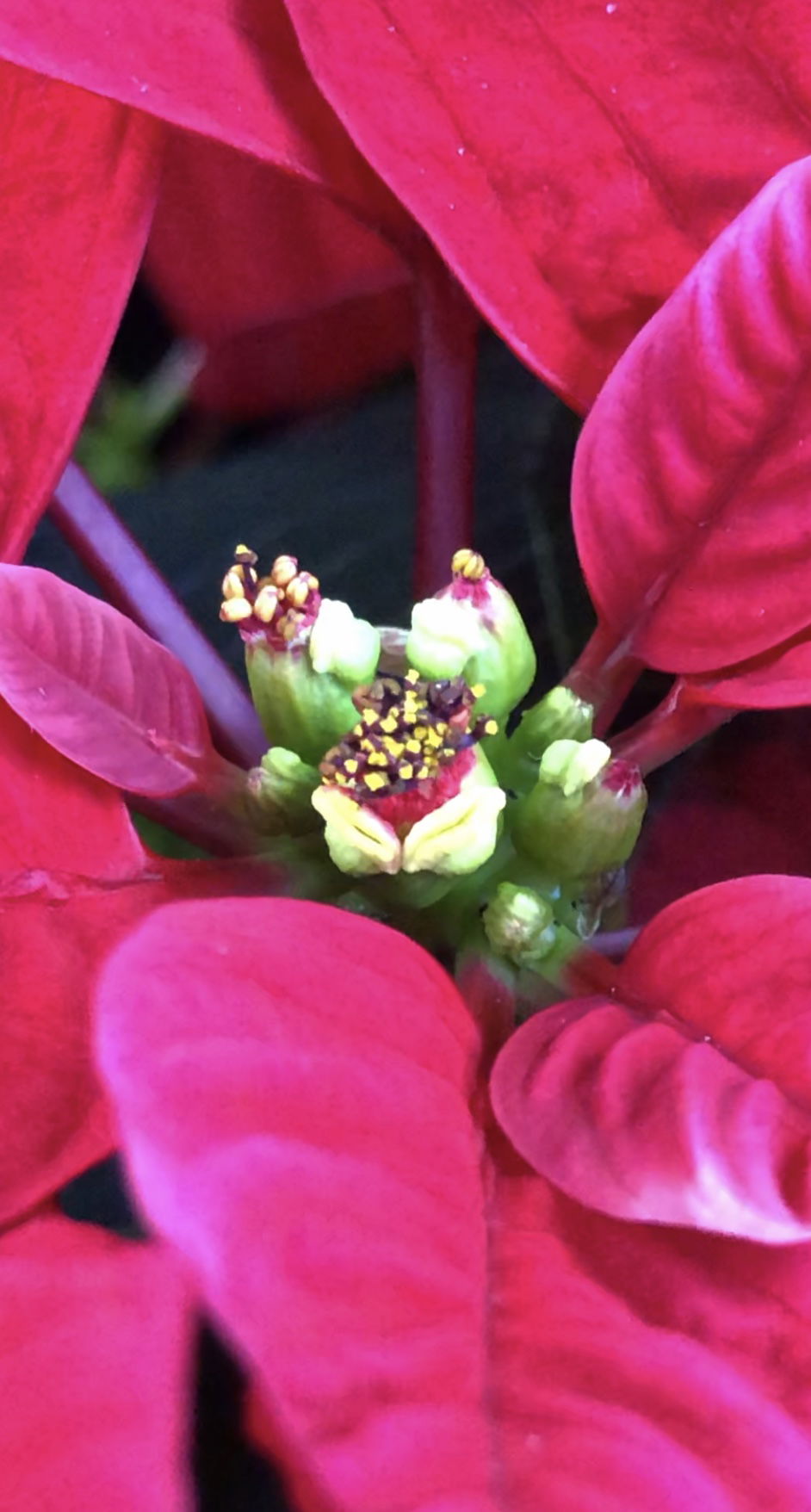 When buying a Poinsettia, choose those with its buds unopened. Pictured above is a specimen with spent flowers.
When buying a Poinsettia, choose those with its buds unopened. Pictured above is a specimen with spent flowers.
Common Issues with Poinsettia
Yellowed lower leaf loss is normal for the first year of its life. Due to the stress of being just a stem cutting at the start of the year (see last image), your plant has had to rush its maturity in time to be sold at Christmas time. Poinsettias are known to be semi-deciduous, meaning it'll naturally lose some of its older leaves in quick succession before a growth spurt in the spring. As the years roll on, your plant will lose less leaves each year as it'll acclimate to your home's environment. Note: If all of your Poinsettia's green leaves have dropped off, don't discard it yet. Keep it well watered/fed and provide a bright windowsill to see if it'll come back within the next two months.
Over-watering is the biggest issue with Poinsettia. Although moist soil is vital for long-lasting flowers and coloured foliage, avoid keeping the compost soggy for extended periods to prevent the chance of root rot. Allow the top quarter of the soil to become dry in between irrigations and always remember to use lukewarm water to avert shocking the tender root systems. Typical signs of over-watering include yellow lower leaves, leaf-loss and stunted growth. Please note that Poinsettia are semi-deciduous, meaning that it's normal for a small number of leaves to drop off over the year.
Under-watering is a lesser-common issue but is still a detriment to your Poinsettia. It's vital to allow the top quarter of the soil to dry out in between waters, but persistent droughts (especially if the plant receives direct light or is near to a radiator) will not be tolerated. Typical signs that you're a little neglectful with its hydration are yellowed leaves, stunted growth, exaggerated leaf-loss and crisping foliage. If this has occurred with your specimen, be sure to increase the frequency of irrigations and remove the affected areas with a clean pair of secateurs.
An improper location is a crucial element to an unhappy specimen. Not only will you have to factor in the amount of light the plant will receive, but you'll also need to consider other elements like humidity, heat-sources and the surrounding temperature. A brightly lit spot with a hint of either morning or evening sun (Before 10am OR after 3pm, but not all day) for around an hour is ideal. Do not place a Poinsettia within four metres of an operating radiator or fireplace as this will immediately lead to leaf curling and crispy foliage. Sudden lower leaf loss could be the result of too low temperatures, so single glazed windows or locations with a slight draught must be avoided, also.
Too little light will have similar effects to over-watering but without the collapsed stem. Its lower leaves will begin to yellow and drop off in quick succession, leaving you with red foliage and an unhappy plant. If you're scared that the location is too dark for the Poinsettia, if a newspaper can be read (when facing away from the light), you're good to go. If this has occurred with your specimen, improve the amount of light fractionally, keeping in mind the increased chance of environmental shock (when two locations offer too different growing conditions) and sun-scorch.
Too much sunlight will lead to sun-scorch, with typical signs including browning or crispy leaves, dry leaf-edges, curled leaves or little growth. Although too low light will cause over-watering issues, too much sunlight will also negatively affect the plant, in the likes of dehydration. A location that offers a splash of direct sunlight either in the morning or evening will bring the optimum growth for the Poinsettia.
A lack of blooms and colourful leaves in the following Christmas period is due to the low quality of its dormancy, served at the start of the same year. Poinsettia will naturally go through the colourful process in the spring to summer months but can be 'tricked' when its ambient temperature and watering frequency are dropped slightly. This will not only slow juvenile growth, but it'll also force the specimen to respond to this change by developing flower buds. Scroll up to 'Dormancy Care' for more information!
Origins
There are around one hundred different varieties of Poinsettia, with the original species originating from several regions in Mexico. The genus was first described back in the early 19th century by Johann Klotzsch and Carl Ludwig Willdenow, honouring the First American Minister to Mexico, Joel Poinsett, who had a keen interest in the plants. Its scientific name, Euphorbia pulcherrima, honours the Ancient Greek physician, Euphorbus, whereas the latter word can be translated from Latin to mean 'very beautiful'.
 The Distribution of Euphorbia pulcherrima.
The Distribution of Euphorbia pulcherrima.
Temperature
15° - 25°C (59° - 78°F).
H1a - can be grown outdoors in summer in a sheltered location, but is fine to remain indoors. If you decide to bring this houseplant outdoors, do not allow it to endure more than an hour or two of direct sunlight a day as this will burn the leaves. The temperature can be reduced to 12°C (59°F) during the spring months whilst the plant is serving its dormancy. Regularly keep an eye out for pests and do not allow temperatures to dip below 15°C (59°C) during the flowering period as irreversible damage may occur in the likes of sudden leaf loss.
Spread
Up to 1.2m in height and 1m in width when grown indoors. The ultimate height will take between 10 - 15 years to achieve. Have a look at the image below at a Poinsettia grown outdoors that's around 4m!
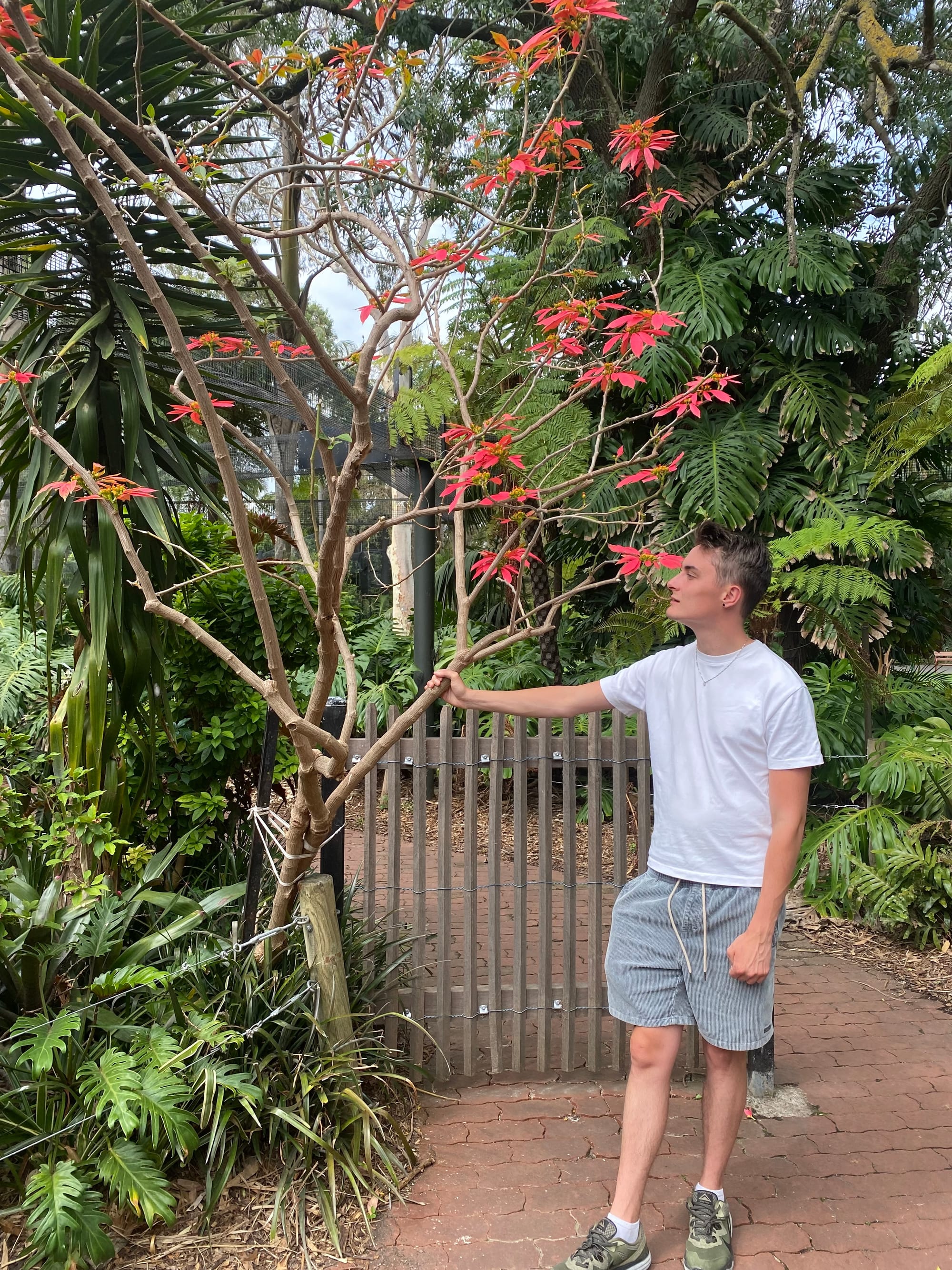 Poinsettia will become trees in the right outdoor settings, but will rarely grow more than 1m in heigh in our homes.
Poinsettia will become trees in the right outdoor settings, but will rarely grow more than 1m in heigh in our homes.
Pruning & Maintenance
Prune off the red bracts (leaves & flowers) once the festive period is over in order for your Poinsettia to focus its energy on producing new foliage in spring. Remember that Poinsettia are known as 'semi-deciduous', so don't worry about a sudden loss of yellowed leaves during the winter; fertilise every third water with a 'Houseplant' feed and keep the soil moist. It'll bounce back in no time!
Propagation
Via Seed or Stem Cuttings.
Stem Cuttings (Easy) - Using a clean pair of scissors, cut a 10cm (4 - 5 inches) section off the stem's terminal. Be sure to use a fresh, damage or pest-free piece as unhealthy divisions are more likely to fail. Remove the older half of the leaves, so that the stem's lower portion is bare, to speed the process of root development. Purchase a 'Cactus & Succulent' compost and vertically push the cutting's base into the soil, avoiding the risk of covering the actual foliage with soil. Situate the cutting in a bright, indirect setting with temperatures above 18°C (64°F). As the roots will develop first, remove the bag and treat it as an adult specimen once there are signs of new foliar development.
Flowers
Poinsettia will naturally flower in spring in their natural habitat, completely missing the Christmas period by a few months. If you'd like to get your specimen to bloom with red bracts during the festive period, introduce a photoperiodic schedule from late summer onwards. Scroll up to the section labelled 'Dormancy Care' for more information. Their flowers are relatively uninspiring, arranged in small clusters at the stem terminals that can last up to several weeks, sporting a yellow tinge.
While choosing a Poinsettia at a shop, choose those that still has its buds un-opened. Those with spent flowers will begin to look a little worse for wear, due to the Poinsettia doing its job in terms of attempted reproduction. The red bracts will begin to fade shortly after.
Repotting
Repot every two years in the spring, using a 'Houseplant' labelled potting mix and the next sized pot with adequate drainage. Hydrate the plant 24hrs before tinkering with the roots to prevent the risk of transplant shock. For those situated in a darker location, introduce an extra amount of perlite and grit into the deeper portion of the pot to downplay over-watering risks. Click on this link for a detailed step-by-step guide on transplantation, or via this link to learn about repotting with root rot.
Book a 1-to-1 video call with THE HOUSEPLANT DOCTOR™ if you'd like a personal guide to repotting your houseplant. This will include recommending the right branded-compost and pot size, followed by a live video call whilst you transplant the specimen for step-by-step guidance and answer any further questions!
Pests & Diseases
Keep an eye out for mealybugs, aphids, spider mites, scale, fungus gnats, blackfly, vine weevils & root mealybugs that'll locate themselves in the cubbyholes and undersides of the leaves, with the exception of the latter two in the soil. Common diseases associated with Poinsettia are root rot, leaf-spot disease, botrytis, powdery mildew & southern blight - click here to learn more about these issues.
Toxicity
Like most Euphorbia, the Poinsettia is considered poisonous if digested by pets and humans. When high quantities are eaten, it'll result in vomiting, nausea and a loss of appetite. The white sap that is secreted when damaged is also toxic, potentially causing skin or eye irritant to sensitive individuals.
Retail Locations
Shortly before and after the Christmas period. Specimens are likely to be found in most garden centres and supermarkets across the world. Choose the healthiest example that sport no signs of stress in the likes of yellowing leaves and limp growth. Never buy a Poinsettia that is sold in temperatures lower than 15°C (59°F) as the cold will shock them to premature death.
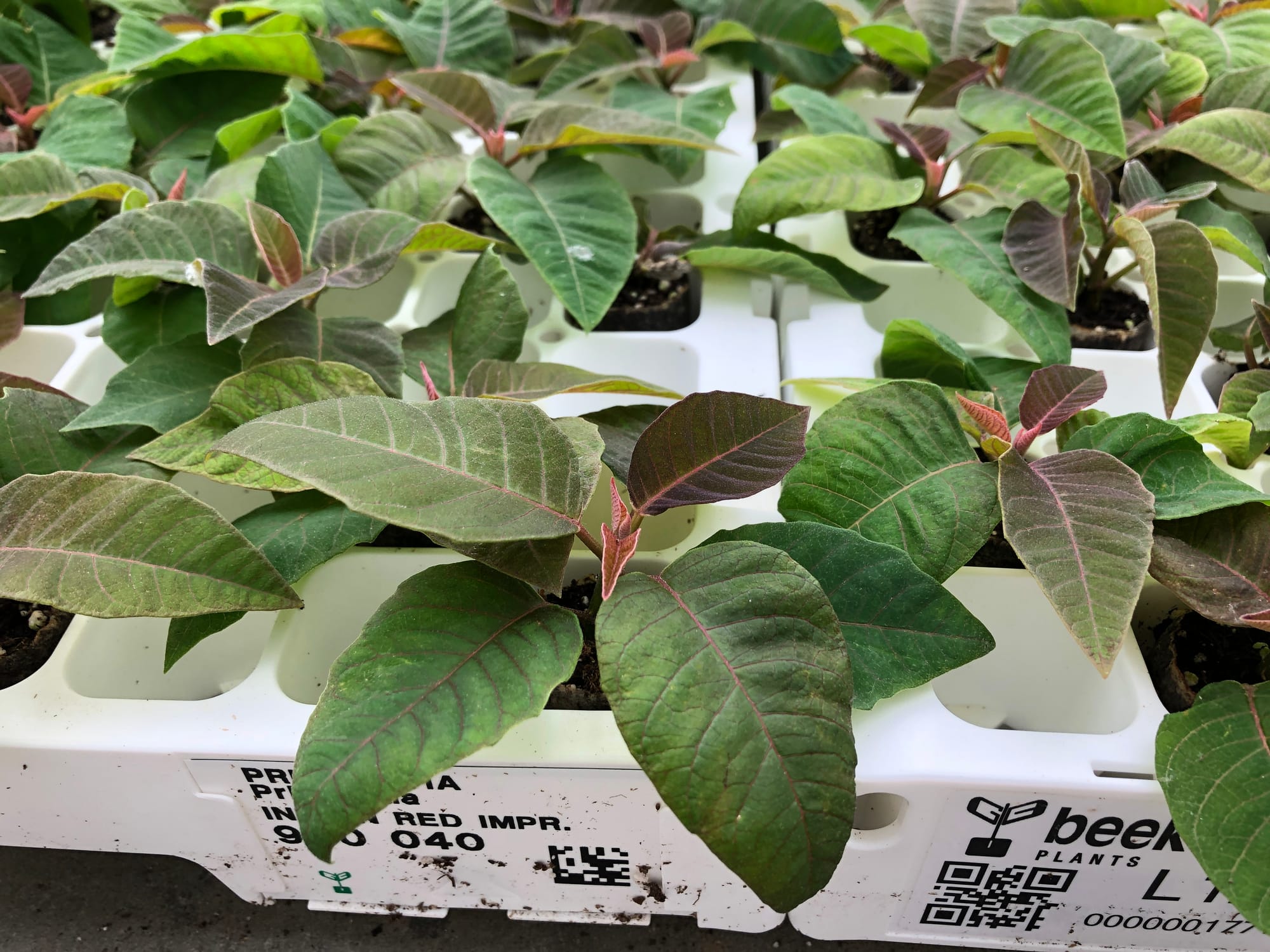 Extra Photo: Poinsettias that you see in garden centres or shops during the festive period would have began their lives as a small 10cm stem cutting in January!
Extra Photo: Poinsettias that you see in garden centres or shops during the festive period would have began their lives as a small 10cm stem cutting in January!
Book a 1-to-1 Call with THE HOUSEPLANT DOCTOR™
If you need further advice with your houseplants, book an advice call with ukhouseplants' friendly and expert writer today! This can be done via a video or audio call on most apps, including Facebook, FaceTime & Skype. A ten-minute call costs £6.95 (US$8), or £15.95 for thirty minutes. You can ask multiple questions, including queries on plants, pests, terrariums, repotting advice and anything in between. Please consider supporting this service to keep ukhouseplants thriving!